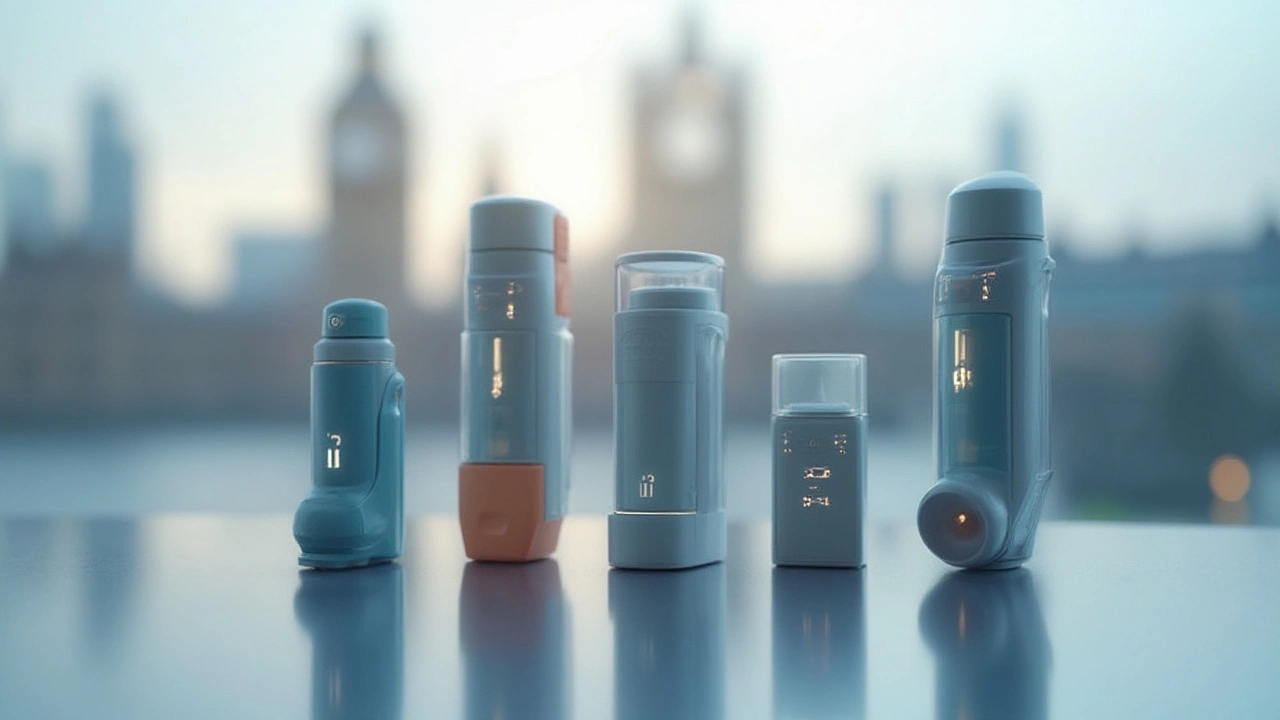The inhaler aisle at the pharmacy used to stress me out. When my son Desmond was first prescribed a controller inhaler, I saw a dozen boxy plastic devices with intimidating names and numbers and felt my brain short-circuit. Fast-forward to this year, Symbicort is a household name—yet people still chase a big question: is there a true Symbicort equivalent inhaler, and if so, how do you pick the right dose or device among the sea of options?
What Makes Symbicort a Standout—and How Do Other Inhalers Stack Up?
Symbicort’s not just a brand. It’s actually a combination inhaler, packing budesonide (a corticosteroid) and formoterol (a long-acting beta-agonist, or LABA). That tag-team effort hits both airway inflammation and tightness. The typical dose for grown-ups is either 80/4.5 mcg or 160/4.5 mcg, which are both inhaled twice a day. Kids like Penelope (depending on age) might use lower strengths.
Here’s the twist: not all combo inhalers work the same way. Advair, Dulera, Breo Ellipta, and AirDuo RespiClick compete in the same league but bring their own recipes and dosing quirks. For example, Advair Diskus uses fluticasone and salmeterol, but not formoterol. Dulera offers mometasone and formoterol, which feels very Symbicort-like on paper but lands differently in dosing and delivery. The device differences—MDI (metered-dose inhalers) vs DPI (dry powder inhalers) vs smart inhalers—also matter a lot for actual use.
Ever notice that even a slight change in device can throw you off? Desmond once switched brands for three days, and I could tell he hated the feel and timing compared to his usual Symbicort. Some inhalers require deep fast breaths (DPIs), others slow-and-steady (MDIs). Kids and older folks often do better with MDIs—with or without spacers—while super dry climates sometimes make DPIs trickier.
Let’s put the ingredient and dose differences front and center:
| Inhaler | Active Ingredients | Available Strengths | Device Type |
|---|---|---|---|
| Symbicort | Budesonide/Formoterol | 80/4.5 mcg, 160/4.5 mcg | MDI |
| Advair Diskus | Fluticasone/Salmeterol | 100/50 mcg, 250/50 mcg, 500/50 mcg | DPI |
| Dulera | Mometasone/Formoterol | 100/5 mcg, 200/5 mcg | MDI |
| Breo Ellipta | Fluticasone/Vilanterol | 100/25 mcg, 200/25 mcg | DPI |
| AirDuo RespiClick | Fluticasone/Salmeterol | 55/14 mcg, 113/14 mcg, 232/14 mcg | DPI |
Notice something? Device choice and dose strengths can trip you up. Breo is once daily, making it feel very different. Advair comes as both Diskus (DPI) and HFA (MDI), but the dose ratios are not interchangeable with Symbicort. You want to match both the steroid and LABA amounts, but also the delivery format and frequency, or you risk under- or over-shooting symptom control. Talk about confusing.

Dose Comparisons: What’s “Equivalent” to Symbicort?
This is where it gets thorny. Doctors talk about “equivalent” doses, but asthma guidelines (like GINA or NHLBI) show these aren’t exact science. For instance, Symbicort 160/4.5 mg twice daily doesn’t perfectly line up with Advair 250/50 mg Diskus twice daily—different ingredient, absorption, and device mechanics mean effects can differ by person.
A lot of folks ask if Dulera is a straight-up Symbicort doppelganger. Both use formoterol, so the fast onset is similar. But Dulera’s steroid (mometasone) is about 1.25x stronger than budesonide. So if you normally use Symbicort 160/4.5 mcg two puffs twice daily, the closest Dulera would be 200/5 mcg two puffs twice daily—but it’s not an exact copycat.
Switching between inhalers isn’t like swapping a faucet part with another brand at the hardware store. Each steroid has a slightly different potency. Here’s a rough reference to make things a little easier:
| Controller Inhaler | Typical Adult Dose | Main Use |
|---|---|---|
| Symbicort 160/4.5 | 2 puffs BID (twice daily) | Asthma, COPD |
| Dulera 200/5 | 2 puffs BID | Asthma |
| Advair 250/50 Diskus | 1 puff BID | Asthma, COPD |
| Breo Ellipta 100/25 | 1 puff daily | Asthma, COPD |
Now, if you’re wondering which of these actually feels like Symbicort in real life? I polled some of the moms from our local asthma support group. About one-third said Dulera’s effect was the most similar, especially during allergy season. Another chunk preferred Advair, mostly due to insurance or taste. And then there are the “I just want the fewest doses” crew—the ones who love Breo for its once-a-day routine.
If you want to see a line-up of the latest options with updated reviews and expert tips, check out this resource on Symbicort equivalent inhalers for deeper comparisons and current prices. It dives into what’s available in 2025, including any new generics and tech-forward devices.

Inhaler Technology: Beyond the Medication, What Actually Matters?
I once thought the only thing that mattered was what’s inside the inhaler. Wrong. Device design changes everything, especially with asthma or COPD, where technique can make or break control. For example, the Symbicort inhaler is a classic MDI, so you need to coordinate pressing down and breathing in. Some folks—kids, elderly, or people with hand problems—struggle with that. Enter breath-activated DPIs like AirDuo RespiClick, which fire the dose as you inhale. Easier, right? But only if your lungs can draw deeply and fast enough; otherwise, it’s wasted medication.
Let’s nerd out for a sec: Newer "smart" inhalers can now track your use, remind you via app, and even tell your provider how often you’re actually taking doses (Penelope finds them hilarious; Desmond, not so much). What’s cooler? Studies in the last two years showed that children using smart inhalers logged up to 35% better adherence compared to non-digital MDIs. That means fewer missed puffs and fewer ER visits. And yes, insurance sometimes covers them as of late 2024—worth checking if you tend to forget evening doses.
There are also differences in the actual feel and maintenance. Symbicort (and generic MDIs) must be shaken, capped, and tested regularly. DPIs can clog—especially if you keep them in steamy bathrooms (I learned this the hard way when Desmond’s Advair whistled but delivered no powder). Spacers are heroes for those with shaky aim, especially kids. And yes, devices come with counter windows now, so the mystery of “did I just take the last puff?” is pretty much over.
Quick tip: If cost matters (and when doesn’t it, with $300+ inhaler co-pays?), check what’s actually on your insurance formulary and ask your doctor to match dose strengths and device type as closely as possible. Generic budesonide/formoterol got FDA approval in 2022, so ask for it if you want a straight-up match to brand-name Symbicort.
Technology and inhaler choices keep expanding. In 2025, you’re no longer stuck with one device or strength. But matching a “Symbicort equivalent inhaler” means weighing the active ingredients, picking the closest dose, and paying attention to the delivery system you’ll actually use—or your kid/parent will actually tolerate. Will your insurance cover generic or branded? Are you better with a click, a push, or do you want an app to nudge you?
It’s a tangled web, but worth unraveling. Ask questions, look up the latest research, and don’t hesitate to seek out comparisons and user tips before you swap inhalers. If you want a deeper side-by-side on choices, device quirks, and costs, that Symbicort equivalent inhalers round-up is a helpful real-world guide—no jargon, just the info you’ll actually need for those hectic moments at the pharmacy.

Octavia Clahar
July 16, 2025 AT 00:18
Wow, the inhaler maze can feel like a horror maze for any parent, and you’ve nailed the confusion perfectly. It’s crazy how the device type can make or break therapy, especially for kids who hate the click‑click routine. I totally get the frustration when the feel of the inhaler changes the whole experience. Keep fighting the pharmacy aisle, we’re all in this together.
eko lennon
July 17, 2025 AT 04:40
Okay, buckle up because the saga of finding a Symbicort doppelgänger is a marathon, not a sprint, and every twist in the dosing matrix feels like a plot twist in a drama series. First off, you have to acknowledge that budesonide and mometasone, while both corticosteroids, sit on slightly different points on the potency scale, which means swapping them isn’t a 1:1 trade. Formoterol, the LABA partner in Symbicort, brings a rapid onset that many people compare to the more sluggish salmeterol found in Advair, so the feel of relief can be worlds apart even if the micrograms look similar on paper. When you look at Dulera, the 200/5 mcg strength mimics the two‑puff BID regimen of Symbicort 160/4.5, but remember the mometasone bump, which effectively nudges the anti‑inflammatory punch up by roughly 20‑25 percent. That extra potency can translate into a quieter night for some patients, yet it can also whisper a subtle over‑suppression warning if you’re not careful. Advair’s fluticasone/salmeterol combo, on the other hand, locks you into a DPI format that demands a deep, fast inhalation, and that mechanical demand alone can cause a dramatic drop in delivered dose for anyone with weaker inspiratory flow. The Breo Ellipta’s once‑daily convenience is seductive, but the vilanterol component has a longer half‑life, shifting the whole pharmacokinetic curve and making a direct potency comparison to twice‑daily Symbicort a near‑impossible arithmetic problem. Then there’s the practical side of insurance formularies, which love to toss generic budesonide/formoterol into the mix, but those generics sometimes come in a slightly different spray‑particle size, subtly affecting lung deposition. The device ergonomics also matter: an MDI like Symbicort forces you to coordinate a press‑and‑inhale, a skill that can ruin adherence for a child who just wants to blow a bubble, while a DPI like AirDuo RespiClick removes the timing issue but adds the requirement for a vigorous inhale that a teenager with mild obstruction might struggle with. In real‑world terms, you’ll hear doctors say “pick the closest dose” while also reminding you to match the inhaler type to the patient’s ability, which is why many pulmonologists will sit you down with a demo kit and a spacer before signing off on a switch. The bottom line is that there isn’t a magical “equivalent” button; you have to balance steroid potency, LABA onset, dosing frequency, and device mechanics like juggling a set of delicate glass spheres. If you happen to be on a high‑dose Symbicort and your insurance only covers a generic MDI, you might need to accept a slightly lower budesonide dose but compensate with proper technique, perhaps adding a spacer to improve deposition. Conversely, if you gravitate toward a DPI for ease, you may have to accept a higher fluticasone amount to keep inflammation in check, which can bring a different side‑effect profile. Ultimately, the choice often comes down to personal preference, insurance constraints, and how well you can master the inhaler’s choreography, not just the microgram numbers on the box. So, when you stare at that pharmacy shelf, remember you’re not just picking a pill; you’re selecting a delivery system that will either empower or frustrate your breathing journey.
Sunita Basnet
July 18, 2025 AT 11:13
Utilizing budesonide/formoterol synergy can achieve glucocorticoid receptor occupancy comparable to fluticasone/salmeterol combos, provided the aerosol particle size distribution aligns with pulmonary deposition thresholds, consequently optimizing therapeutic index while minimizing systemic exposure. Moreover, adherence metrics improve when device actuation force is within ergonomic comfort zones, especially for pediatric cohorts.
Melody Barton
July 19, 2025 AT 17:46
Don’t let the pharmacy push a DPI if you can’t pull a deep breath, it’s a waste of meds. Grab an MDI with a spacer and you’ll see better control fast.
Justin Scherer
July 21, 2025 AT 00:20
When you’re weighing options, think about the routine that fits your life – two puffs twice a day vs one puff once a day can change how you remember to take it. Also check if your insurance covers the generic budesonide/formoterol, it can save a lot of cash. Most importantly, practice the technique with your doctor so you actually get the dose you need.
Pamela Clark
July 22, 2025 AT 06:53
Oh great, another endless list of inhalers to confuse us – thanks, pharma.
Diane Holding
July 23, 2025 AT 13:26
Pick what you can actually use.
Cheyanne Moxley
July 24, 2025 AT 20:00
Honestly, if you’re not taking the time to learn proper inhaler technique, you’re doing yourself a disservice and wasting precious medication. Get educated, then decide which device truly matches your lifestyle.